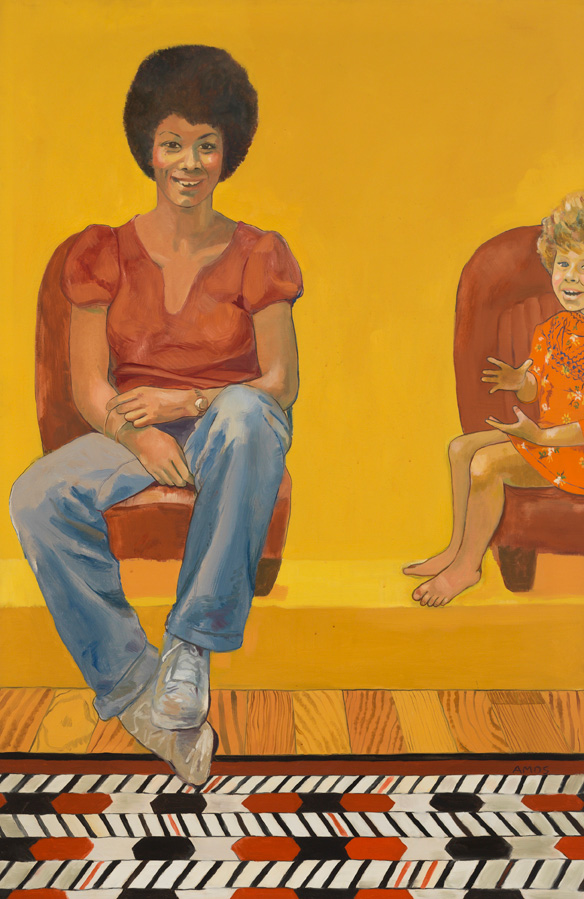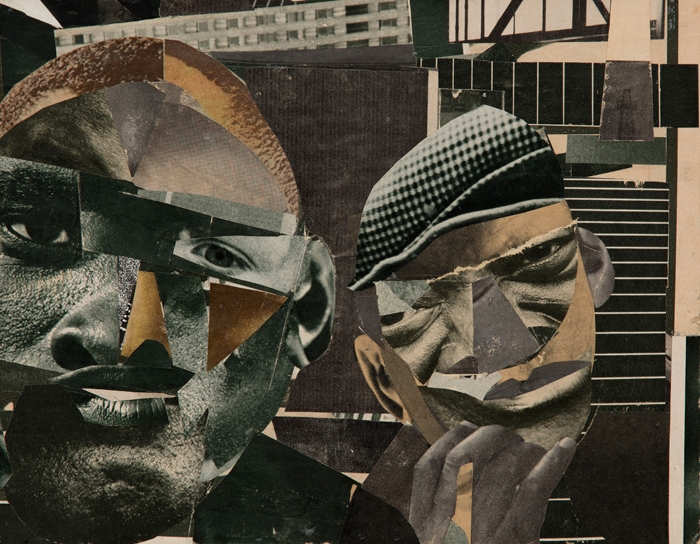‘Soul is black’. This was reportedly Aretha Franklin’s response when entreated for a definition of soul. Tate Modern’s survey of African-American art – encompassing over 65 artists through two decades from 1963 – asks what is black? Artist Raymond Saunders provided a formalist answer with his 1967 pamphlet ‘Black is a Color’. Indeed, black is present in that literal sense. Martin Puryear’s Self (1978) is a simple biomorphic form made of hollow wood stained nearly obsidian. It’s a portrait, the artist described, of a secret self. In the chiaroscuro photography of Roy DeCarava, figures emerge from stygian cityscapes: saxophonist, chanteuse, mourners, Malcolm X. Within Jack Whitten’s triangular canvas Homage to Malcolm (1970), jet-black acrylic was raked with an Afro comb. The intervening tool, both totemic and quotidian, unearthed vivid hues, suggesting multivalence.
Ed Clark’s Yenom (#9), produced the same year, is an oval canvas of horizontal stripes in Mediterranean shades. Clark used a janitor’s broom as a wide brush, bringing along studio dirt and footprints to the surface. There’s no black evident, nor perhaps blackness. But it’s difficult to ignore the context: Clark was the first American painter known to experiment with irregularly shaped canvases, yet remains not quite canonical. It’s also possible to consider his technique in the terms of Frank Bowling, who in 1971 situated nonfigurative black artists that do not abstract current sociology, but rather absorb the diasporic traditions of black people rearranging and redirecting found things in whatever environment they’ve been ‘thrown, placed or trapped’.
Soul of a Nation begins with the formation of the New York collective Spiral, whose first group show featured works in black and white. Paintings by Norman Lewis represent marchers – both Klansmen and civil rights activists – through uncanny white strokes against a field of black. Spiral’s statement began, ‘During the summer of 1963 at a time of critical metamorphosis just before the historic March on Washington, a group of Negro artists met to discuss their position in American society.’ The year was also indelibly marked by the bombing of a Baptist church in Birmingham, Alabama, that left four black girls dead. Through a period in which the position of African Americans was being articulated with blistering passion on the political stage, Soul of a Nation considers the multifarious, sometimes contentious ways in which black artists negotiated aesthetic considerations. ‘Is there a Negro image?’, enquired Lewis. This forms the crux of the show, the only consensus being that there are many.

As with ‘soul’, the ‘nation’ of the title can be read as having precise or indeterminate connotations. It suggests the indispensability of African-American contributions to American art, but could also bring to mind a separatist sect like the Nation of Islam or Funkadelic’s One Nation Under a Groove. In his 1970 poem ‘It’s Nation Time’, Amiri Baraka posited nationhood as prospective. The many voices here are heterogeneous and often conflicting. Avantgarde practitioners found detractors in activists who prioritised direct community engagement. Projects by the latter, documented in photographs, reveal further disagreements – over whether a mural, for instance, is only legible when depicting heroic phrases and figures, or has the potential to modulate its site via uplifting colourways. If such stances constitute nations of thought, there are whole other universes: the prismatic collage of Romare Bearden, the jumbled sculptures by Noah Purifoy and Betye Saar – tellurian yet otherworldly, they seem to result from new rituals.
There’s something peripatetic here, and exigent. This iteration (the exhibition next travels Stateside) has an erratic flow. It reflects the ethos of the Spiral group, so-monikered because a spiral ‘moves outward embracing all directions, yet constantly forward’. Certain rooms are organised by region: the psychedelic vibe of Chicago, the California soul mined from arid deserts and fuliginous underpasses. Others are dedicated to a particular medium or method. In one cramped space, propaganda posters jostle like a crowd, by turns emboldened or acrimonious. The final room is devoted to a single gallery, Just Above Midtown, and its ephemeral output. Here, winglike sculptures by David Hammons comprise urban flotsam: greasy paper bags, hair tufts, shards of vinyl. ‘You’ve got tons of people’s spirits in your hands when you work with that stuff,’ the artist stated.
The exhibition climaxes with an expansive space of largescale works themed around improvisation and experimentation. In Joe Overstreet’s We Came from There to Get Here (1970), a vibrant canvas, detached from its stretcher, is hoisted through ropes and grommets like a suspended tent. It registers as ecstatic until one considers the allusion to lynching. This duality perplexes like a ritual in which an observer cannot decipher rapture from grief. Next to it hangs Al Loving’s Untitled (1973), a loamy assemblage of variegated canvases, hide, leopard skin and braided cords. It conveys both extemporaneity and ineluctable thingness. In 1969 Loving was the first African American to mount a solo show at the Whitney Museum. Vexed by the resistance of black colleagues who felt his work conformed to hegemonic criteria, Loving developed a visceral objection to formal geometries, prompting him to tear previous canvases apart. Subsequent works, some appropriating those scraps in the manner of quilting, are resolute yet loose. The artist has spoken of the ancient African religion of animism, in which ‘all objects in nature had a soul and those souls had their own independent integrity’. With such unshackled sculptural work, Loving may have arrived at his own autonomy.
Soul of a Nation: Art in the Age of Black Power, Tate Modern, London, 12 July – 22 October 2017; Brooklyn Museum, New York, 14 September 2018 – 3 February 2019
From the October 2017 issue of ArtReview
